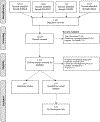Transgender stigma: A critical scoping review of definitions, domains, and measures used in empirical research
- PMID: 32163820
- PMCID: PMC7442603
- DOI: 10.1016/j.socscimed.2020.112867
Transgender stigma: A critical scoping review of definitions, domains, and measures used in empirical research
Abstract
Rationale: A growing body of transgender (trans) health research has explored the relationship between stigma and health; yet, studies have conceptualized and operationalized anti-trans stigma in multiple ways.
Objective: This scoping review aims to critically analyze quantitative measures of anti-trans stigma in the U.S. using a socioecological framework.
Method: We organized and appraised measures from 126 included articles according to socioecological level: structural, interpersonal, or individual.
Results: Of the identified articles, 36 measured anti-trans stigma at the structural level (i.e., institutional structures and policies), 102 measured anti-trans at the interpersonal level (i.e., community interactions), and 44 measured anti-trans stigma at the individual level (i.e., internalized or anticipated stigma). Definitions of anti-trans stigma varied substantially across articles. Most measures were adapted from measures developed for other populations (i.e., sexual minorities) and were not previously validated for trans samples.
Conclusions: Studies analyzing anti-trans stigma should concretely define anti-trans stigma. There is a need to develop measures of anti-trans stigma at all socioecological levels informed by the lived experiences of trans people.
Keywords: Measurement; Stigma; Transgender; United States.
Copyright © 2020 Elsevier Ltd. All rights reserved.
Figures
References
-
- Austin A, & Goodman R (2017). The impact of social connectedness and internalized transphobic stigma on self-esteem among transgender and gender non-conforming adults. J Homosex, 64, 825–841. - PubMed
-
- Bakko M (2018). The effect of survival economy participation on transgender experiences of service provider discrimination. Sexuality Research & Social Policy: A Journal of the NSRC.
Publication types
Grants and funding
LinkOut - more resources
Full Text Sources



